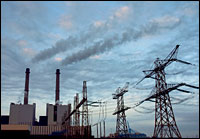It’s the world’s largest machine — the interconnected network of power plants, transmission towers, substations, poles, and wires that make up the power grid. When you flip the switch you expect the juice to flow and don’t have much reason to think about it, except during the occasional blackout. Power engineers and energy wonks might get passionate about the grid, but for most people it’s just a background fact of life.

It’s time to bring the grid into the foreground, because it positions at the exact center of the world’s most crucial issue, global climate change. The power grid is the source of one-third of U.S. global warming emissions. Unless we clean it up we cannot avert severe climate change. The grid is also the key to electrifying transportation and making more effective use of heat generated for buildings and industry, source of the vast bulk of remaining emissions. The grid can be the ultimate climate saver.
But today’s power grid cannot do it. A system built on central generating stations, little changed from the first power grids deployed in the late 1800s, lacks flexibility and smarts. We need a new grid capable of networking millions of distributed energy devices such as solar panels, wind turbines, electric vehicles, and smart appliances. We need an internet of energy that employs the latest in digital technologies. We need a Smart Grid.
On August 14, 2003, an overheated transmission line in Ohio sagged into the power grid’s greatest natural enemy, a tree branch. The resulting power failure cascaded from the Midwest to Broadway in seconds. Power grid operators were quickly on the phones trying to grope through the grid equivalent of the fog of war, but it was too late. The biggest blackout in U.S. history was underway, leaving 50 million people without power.
The event underscores a crucial fact. Of all major infrastructures, the power grid is the least automated by digital technology. Contrast the big box chain which keeps a constant inventory linking checkout stand to warehouse with the utility which must send its linemen into the field to hunt out downed power lines. Or set the control room operator balancing power plants and demands against the internet, constantly rerouting information flows. Modern digital systems rely on real-time data and automated responses, while the grid functions on delayed information and human decisions.
The immediate implication is declining power reliability as demands on the grid grow. Columbia University grid researcher Roger Anderson notes that “since 1998, the frequency and magnitude of blackouts has increased at an alarming rate … If present trends continue a blackout enveloping half the continent is not out of the question.”
But the more serious long-term implication is that the grid cannot take on the tasks it needs to accomplish to reduce global warming pollution. Look on the grid of today as if it were the old computer network with a mainframe computer at the hub and terminals at the end of the spokes. The “mainframe” of the grid is the central power station. Transmitting power out the spokes to end users is a relatively simple management task compared to a system in which power generators are distributed throughout the network and power flows are many-way. Utility engineers typically resist distributed generation specifically because it makes their management task more complex. Most states have now enacted net metering laws which require utilities to interconnect small-scale distributed generators, but cap the total amount in the system to avoid destabilizing the grid.
So far solar photovoltaic panels, small-scale wind-power generators, fuel cells, and other localized generators have not penetrated far enough into the market to raise much of a challenge. But consider the moment at which breakthroughs are achieved and distributed generation experiences an explosive takeoff, as a number of observers project for solar PV power. Then power distribution systems will have to be automated. In effect, an information internet backbone will automatically route and manage the complex power flows of the energy internet.
Cogeneration is prospectively one of the largest distributed energy sources. Building and industrial heat could be recycled to generate electricity on-site. Interconnection to the grid can make the business case for a cogen unit, providing a market for surplus and a grid backup when the unit is down. But utilities discourage these kind of connections, again, because they pose complex management problems. Smart Grid systems will make cogen far more economically feasible.
In transportation, improvements in battery technology are stirring new interest in electrified options, including plug-in hybrids and pure battery vehicles. Mass-scale electrified transport will require Smart Grid systems. One function will be to match charging times to clean power availability. For example, in many regions wind power tends to be generated at night. A Smart Grid can send real-time signals to plugged-in vehicles alerting them to charge when turbine blades are turning. Another Smart Grid function will be to manage vehicle-to-grid networks in which electrified fleets supply power to the grid as well as receive power from it. Making intermittent renewables into a 24-7 power source requires energy storage, and our cars which generally sit parked 22 hours a day are an ideal match. Smart systems will manage “V2G” networks.
An energy systems revolution is upon us, and the Smart Grid is at its very center. In future installments I will drill down more into the capabilities and potentials of the Smart Grid, as well as the obstacles and challenges along the road there. Meanwhile, for those who want to read up, check out my paper, “Powering Up the Smart Grid” for one of the most complete overviews of the topic.


